First Flight:
Terry Smith
![]()
First Flight:
|
|
by Alfred Scott
This article appeared in the June 1989 issue of the Falco Builders Letter. |
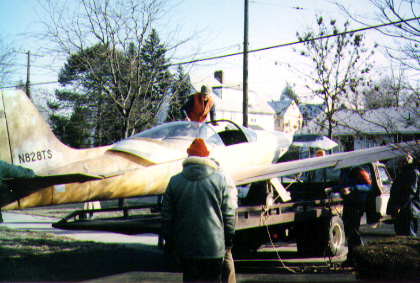
Moving the Falco to the airport.
The 20th Sequoia Falco flew on April 12th. The proud builder is Terry Smith, of Forty Fort, Pennsylvania, who built the Falco over a five-year span.
This is easily the most powerful Falco ever to fly, as it has a High Performance IO-360-B1E which has been polished and ported. The engine was checked on the dynamometer and produced 192 hp at 2700 rpm. The Falco came in a bit heavy, at 1,271 lbs empty with engine oil, and Terry worried a little about this-until he flew the plane.
Terry flew the Falco at 6:30 in the morning from the Wyoming Valley airport, and he reported " the Falco jumped off the runway like a kangaroo. I chose to keep the event small to prevent a circus attitude and no undue go-or-no-go decisions. It was only witnessed by my wife Mae who video-taped the flight and one flight instructor from my pilot's club who talked with me during the flight. The plane literally jumped off the ground in a few hundred feet. Once I was 50 feet in the air and knew it was going where I pointed it, the anxiety left and the pleasure and excitement set in."
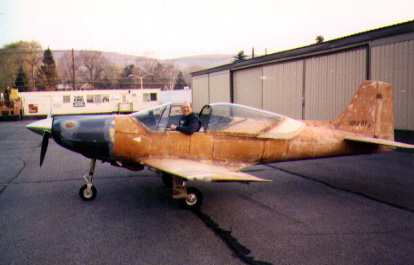
Terry Smith after the first flight.
"Some preliminary figures show reasonable buffet and stall around 55 knots in clean configuration. One hundred and seventy knots indicated and 184 knots true airspeed at 7,000 feet. It climbs at 2,000 ft/min. It handles beautifully during landings as far as I'm concerned, however, I'm used to the sink because most of my time has been in a T-tail Arrow. The stick just comes naturally."
The final inspection was, well, interesting. The inspector was placard-crazy and spent all of his time looking at the placards on the panel. He finally noticed that there is no way to open the canopy from the outside and told Terry to put an "in case of emergency, break glass" placard on the canopy. Terry could scarcely believe it. The bureaucrat barely looked at the airplane and only once when he came up for a breather from placard inspections did he manage a sideways glance and an oh-by-the-way, looks-like-you-did-a-nice-job comment on the airplane.
With abortion now generally accepted by all but the religious right, perhaps it's time to consider 'doing something' about bureaucrats when they are still tiny babies. Mothers can easily recognize them by a glazed-over look, lethargic behavior and early response to 'pension', 'job description' and 'not my department.' Surely there is some legal way that parents can quietly save society from this scourge. Chores after 4:30. Games that require imagination. Sunlight.
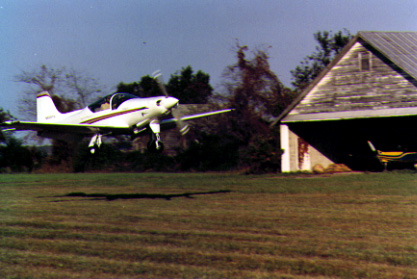
Subsequently painted, here's the Falco landing at the Oyster Fly-In.
Terry's Falco is perhaps the ugliest Falco yet to fly, outfitted in something he calls "Rommel brown," for the Falco has not one drop of paint on it. Instead, it is just fiberglass-over-birch-plywood with spots and dabs of microballoons. The Falco is going to be painted professionally, and Terry wanted to get it in the air and debugged before he took it to the paint shop.
There have been a number of problems. After about 4 hours of flying, the crankshaft oil seal developed a leak and its replacement required removing the cowling and propeller. The exhaust is very close to the cowling at two places and was burning the fiberglass, so Terry made a little blister at each trouble spot. The directional gyro was misbehaving, so he sent that back to IFR who gave him a fast turn-around.
There are still two problems that remain. Terry has the full gear doors and while the gear retracts without incident on jacks, the circuit breaker consistently pops with four turns to go on gear retraction. I told Terry about Jim Slaton's experience with heated tire expansion (see "Around the Falco Patch"), and Terry is beginning to investigate this. As a simple experiment, once he had been airborne long enough for the tires to cool, he slowed the plane down, extended the gear and then selected gear-up. This time the circuit breaker popped with only two turns to go. Terry plans to smear some grease on the tires to see where it is hitting. (As we go to press, Terry reports that he found the problem with the tires hitting the doors.)
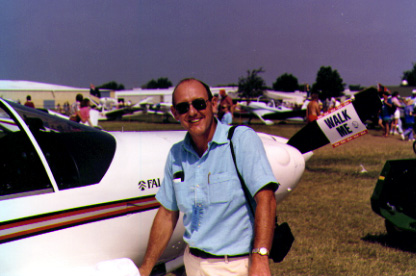
Terry Smith at Oshkosh.
The other problem is noise in the electrical system. Terry's initial thought was that the problem was with the alternator, and he had the alternator worked on. With some new brushes, the system was noticeably quieter, but it's still objectionable and causes the ADF needle to swing 60° off course. Terry also reported that the electric fuel pump is noisy.
Terry began to talk about putting a noise filter on the alternator. I called my friend, Walter Marsh, who understands electricity better than most people, and Walter thought it was not an alternator problem. Alternators are normally rather quiet, and any noise that they do generate would be caused by bad brushes, loose connections or a not-grounded shield on the field wire. Instead, Walter thinks the problem is probably a poor connection in the audio circuit, which would set up a high resistance that would make a scratchy noise.
I think Walter is right and asked Terry to check all of the other motors. So far, he has found that the flap motor, fuel pump, alternator and magnetos all are making noise. He hasn't check the landing gear motor yet, but it's obvious to me that the problem is not with the alternator, motors or magnetos. Something in the system is amplifying the little noise they make. This type of problem is very annoying and difficult to find, but you have to simply go through the system and isolate the problem by shutting things off.
The Falco, N828TS, is now upholstered with a conservative light grey interior, velour seats and with charcoal grey carpet. Black and red vinyl is used for trimming around the cockpit and to pick up colors that will be used in the paint scheme. We don't have any hard numbers on the performance yet, but Terry talks about seeing 165-170 knots indicated at 6,000 feet. The rate of climb, as would be expected, is spectacular.
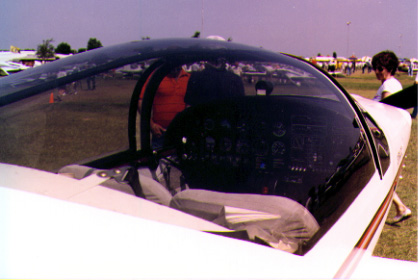
Horsepower alone does not make a fast airplane. Homer Woodard put a High Performance polished-and-ported 340 hp Aerostar engine in his SF.260 and got only 9-12 knots more at cruise. At Farmerville a couple of years ago, Homer leaned on the propeller and said, "Now I'm not saying I'm sorry I did this, but..." and went on to explain that it wasn't worth the effort or expense. "Frati knew what he was doing when he selected a 260 hp engine for this airplane." Later that same day in a friendly little race, Jan Morgan beat Homer in his stock 260 hp Marchetti that he had simply cleaned up. Of course, if you clean up the airplane and add power, it will go like stink.
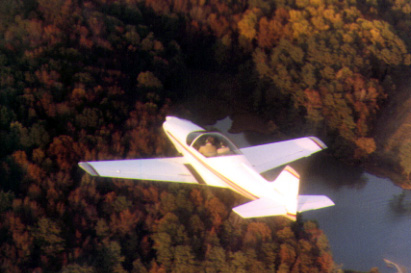
Terry says, "For those wondering how to get the plane to the airport, it will fit on a tip-back car carrier with a few inches to spare. It was quite an event for our small town. The state police closed three lanes of U.S. 11, and I was escorted by 5 police cars the two miles to the airport. The approach control at Wilkes-Barre, which is 7 miles away, has been most helpful during the testing and allows me to fly any altitude and direction that I choose."
Terry is back in the air and has about 7 hours on the plane. If all goes well, he will have the restrictions flown off soon and should get the Falco into the paint shop in time to make Oshkosh.
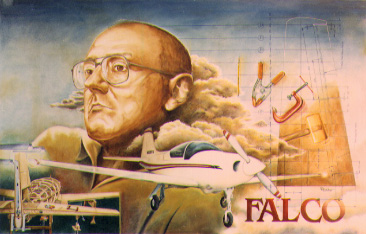
Artist's rendering of Terry and his Falco.